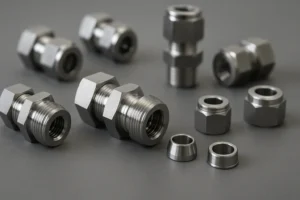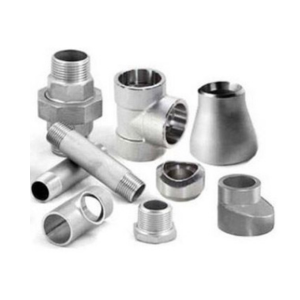Contact : +91-79045 61980 | Email: hydrofitengineers@gmail.com
What Are Ferrule Fittings? Working, Types & Applications

In any hydraulic or instrumentation system, reliability and leak-proof performance are non-negotiable matter. And that’s where you benefit from Ferrule Fittings. These precision-engineered components create tight, vibration-resistant seals between tubes and fittings – ensuring system integrity in even the most demanding industrial environments.
Laser-cut and precision-formed, these top-quality parts produce tight, vibration-resistant fit that stays locked despite many years of high heat and other harsh conditions. We have single ferrule and double ferrule compression fittings are durable, wear well and get the job done for years. Hydrofit Engineers is an esteemed manufacturer of DIN & ISO standard Ferrule Fittings in Chennai. our guarantee is to make quality centric products that last long.
What Are Ferrule Fittings?
Ferrule fittings are mechanical tube fittings which is used to connect, seal, or terminate tubing systems without welding. They consist of three primary components – the body, nut, and ferrule (or two ferrules in double-type designs).
As the nut is tightened, the ferrule bites into the tube and then on to the fitting body to provide a high-pressure, vibration-resistant seal that can withstand variations in temperature and pressure. These fittings are common and used in hydraulic systems, gas cylinders, instrumentation setups and many other applications which require secure connections between two lines
The operation of ferrule fittings is based on mechanical grip and compression sealing. A Ferrule Fitting is a type of fluid connection fitting widely used in process, oil and gas industries for achieving a leak free joint between two pipes or tubing. Generally consists of three distinct parts:
- Body: The main part that connects with the tube and the system.
- Nut: Supplies the axial load that compresses the ferrule(s).
- Ferrule(s): The metal ring(s) which collapses or bite into the tube’s surface to form a positive grip.
This double-action sealing principle ensures zero leakage even under high pressure, vibration, and temperature fluctuations – a major reason these fittings dominate instrumentation and hydraulic applications. As the nut is tightened, and the ferrule mates against the outer surface of the tube. This provides a mechanical grip, and metal to metal seal which eliminates leaks from high pressure flanges.
How Ferrule Fittings Work
The principle behind ferrule fittings lies in controlled deformation.
Tightening the nut drives the ferrule forward. The front of the ferrule is wedged between the tube and fitting body to form a pressure-tight seal. At the same time, its rear edge holds the tube so as to prevent it from slipping or unscrewing if under pressure or action of vibrations.
In double ferrule fittings, the system uses two ferrules:
The front ferrule creates the seal against the body.
The back ferrule seats to the tube and provides even pressure on clamping.
This two-action process offers increased Vibration, thermal shock and pulsation resistance which is suitable for use in hydraulic, marine and petrochemical systems.
Types of Ferrule Fittings
There are several types of ferrule fittings and you can select one based on the system design, pressure rating and material compatibility. The two most frequent forms are:
1. Single Ferrule Fittings: These single ferrules does work of sealing as well as gripping functions.
A single ferrule does work of sealing as well as gripping.
Consist of one ferrule for seal and gripping.
Great for moderate-pressure and vibration systems.
Used in general purpose hydraulic and pneumatic lines.
2. Double Ferrule Compression Fittings: Double ferrule fittings have two separate ferrules, one for sealing and another for gripping.
Feature a front and back ferrule for enhanced sealing and stability.
It is suitable for high-pressure, high-vibration hydraulic circuits.
Deliver excellent resistance to thermal cycling and mechanical stress.
Suitable for instrumentation, oil & gas, and marine applications
At Hydrofit Engineers, we specialize in manufacturing both single ferrule and double ferrule compression fittings using advanced CNC machining and forging technologies to ensure tight dimensional tolerances and optimal sealing performance.
Materials and Standards Compliance
The choice of material is critical to specify and ensure the long term performance of ferrule fittings.
Hydrofit Engineers Fittings are made through :
- Stainless Steel (SS316 / SS304)- Excellent corrosive and strength resistance for the most demanding applications.
- Brass Fittings- Inexpensive and dependable when used in low pressure or non-corosive environment.
- Carbon Steel- For high pressure hydraulic field, long life solent system.
Our ferrule fittings are conform to DIN2353 and ISO standard, and are interchangeable with other manufacturers, so all our parts come with precision tolerance and worldwide acceptance.
Technical Advantages of Ferrule Fittings
Ferrule fittings are demanding fittings product across industries due to their unique combination of engineering precision and operational reliability. Key advantages include:
Leak-Proof Performance: It ensures tight, long-lasting sealing without need for sealants.
High Pressure & Temperature Resistance: These fittings are designed for demanding hydraulic conditions.
Ease of Assembly: No special tools or welding required, only simple hand-tight installation is enough.
Vibration Resistance: Double ferrule design prevents tube loosening under dynamic loads.
Reusability: It can be reassembled multiple times without downgrading the performance.
Wide Material Compatibility: These ferrule fittings are suitable for metal and polymer tubing systems
Applications Across Industries
Ferrule fittings are indispensable in industrial sectors where precision and safety are mission-critical.
- Oil & Gas Industry: Used in instrumentation panels, pressure gauges, and hydraulic lines exposed to high vibration and temperature.
- Power Generation Plants: Applied in fuel lines, cooling systems, and lubrication circuits for turbine and generator units.
- Marine and Offshore Applications: Preferred for seawater-resistant connections that can withstand corrosion and pressure surges.
- Petrochemical and Chemical Plants: Ideal for corrosive environments requiring chemical-resistant seals.
- Vacuum and Gas Applications: Maintain vacuum integrity and prevent leakage in sensitive lab or process setups.
- Instrumentation Systems: Used in control panels, process measurement lines, and hydraulic systems for precise fluid handling.
Ferrule Fittings vs. Compression Fittings
It’s not about tube or hose sizes but the difference is in precision design and sealing technique when both ferrule and compression fittings are used to connect tubes.
Compression Fittings: These typically use a soft ferrule or olive to make a seal and are used on lower pressure.
Ferrule Fittings: But ferrule fittings create a metal-to-metal seal for use in high-pressure, vibration, and impulse hydraulic lines.
Thus, every ferrule fitting is a type of compression fitting whereas not every compression fitting equal the mechanical strength and leak tight fit found in ferrules.
Hydrofit Engineers backed by a rich industry experience of more than 20 years, we are one of the most genuine and reliable names in the field of manufacturing hydraulic fittings based in Chennai as well all over India.
Our on-site forging, CNC machining, and inspection place rods in the hands of our customers with the confidence that they are receiving the best product available at any price.
Searching for dependable ferrule fittings? Explore Our Ferrule Fittings Product Range or contact us for quick deliveries.
FAQs
What are Ferrule Fittings used for?
Ferrule fittings are used in a wide variety of hydraulic and instrumentation systems where tubes need to be connected together to provide the highest level of leak-proof, high-pressure performance without having to weld or solder these connections.
What is the difference between single and double ferrule fittings?
Single ferrule fittings have one ferrule to seal, and double ferrule fitting has two to seal + holding (better vibration tendency).
Are Ferrule Fittings reusable?
Yes, Ferrule fittings can be reassembled with the same torque values and used repeatedly without loss of sealing effectiveness.
Which standards do Ferrule Fittings follow?
Hydrofit Engineers produces ferrule fittings to DIN 2353 as well as ISO specifications, thereby offering global interchangeability and performance.
In which industries are Ferrule Fittings commonly used?
Due to a leak-proof and anti-corrosive construction, these are employed throughout oil & gas systems, marine applications, power generation equipment, vacuum systems as well as for instrumentation lines.

